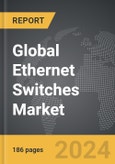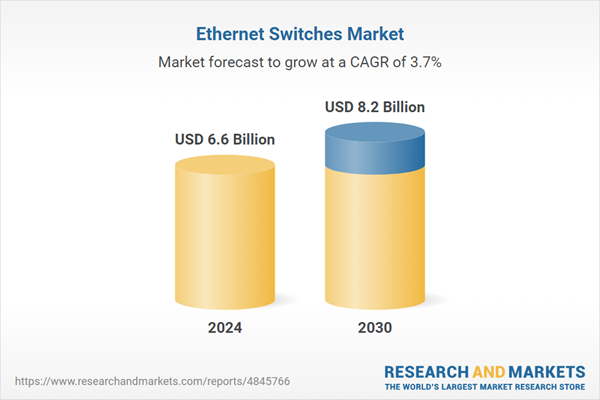The global market for Ethernet Switches was valued at US$6.6 Billion in 2024 and is projected to reach US$8.2 Billion by 2030, growing at a CAGR of 3.7% from 2024 to 2030. This comprehensive report provides an in-depth analysis of market trends, drivers, and forecasts, helping you make informed business decisions. The report includes the most recent global tariff developments and how they impact the Ethernet Switches market.
Segments: Type (Modular Ethernet Switches, Fixed Configuration Ethernet Switches); End-Use (Small Enterprises, Medium Enterprises, Large Enterprises).
Geographic Regions/Countries: World; United States; Canada; Japan; China; Europe (France; Germany; Italy; United Kingdom; Spain; Russia; and Rest of Europe); Asia-Pacific (Australia; India; South Korea; and Rest of Asia-Pacific); Latin America (Argentina; Brazil; Mexico; and Rest of Latin America); Middle East (Iran; Israel; Saudi Arabia; United Arab Emirates; and Rest of Middle East); and Africa.
The analysts continuously track trade developments worldwide, drawing insights from leading global economists and over 200 industry and policy institutions, including think tanks, trade organizations, and national economic advisory bodies. This intelligence is integrated into forecasting models to provide timely, data-driven analysis of emerging risks and opportunities.
Global Ethernet Switches Market - Key Trends and Drivers Summarized
What Are Ethernet Switches and How Do They Function?
Ethernet switches are pivotal components in networking, essential for connecting multiple devices within a local area network (LAN). They operate by receiving data packets from connected devices and directing them to their intended destinations within the network, ensuring efficient and reliable communication. Unlike hubs, which broadcast data to all devices in the network, Ethernet switches create a dedicated path between the sending and receiving devices, reducing collisions and improving overall network performance. These switches come in various types, including unmanaged, managed, and smart switches, each offering different levels of control and functionality. Unmanaged switches provide basic connectivity without the need for configuration, making them ideal for simple setups. Managed switches offer advanced features such as VLANs, Quality of Service (QoS), and port mirroring, allowing for greater control and optimization of the network. Smart switches strike a balance, offering some management capabilities without the complexity of fully managed switches.How Are Ethernet Switches Evolving with Technological Advancements?
The evolution of Ethernet switches is closely tied to advancements in networking technology, particularly the increasing demand for higher bandwidth and faster data transfer rates. The transition from 1 Gigabit Ethernet (GbE) to 10 GbE, and now towards 40 GbE and 100 GbE, exemplifies this trend, driven by the need to support data-intensive applications such as video streaming, cloud computing, and big data analytics. Modern Ethernet switches are also incorporating support for Power over Ethernet (PoE), which allows them to deliver power to connected devices such as IP cameras, wireless access points, and VoIP phones, simplifying installation and reducing cabling requirements. Furthermore, the development of software-defined networking (SDN) is transforming the way networks are managed, with Ethernet switches playing a crucial role in enabling dynamic and programmable network configurations. These advancements not only enhance the performance and flexibility of Ethernet switches but also enable them to meet the growing demands of contemporary networking environments.What Are the Key Applications and Market Trends for Ethernet Switches?
Ethernet switches are integral to various applications across different sectors, reflecting their versatility and critical importance. In the enterprise sector, they form the backbone of corporate networks, supporting seamless communication and data exchange among employees and systems. Data centers, which require robust and high-speed connectivity to manage vast amounts of data, heavily rely on Ethernet switches to ensure efficient network performance and scalability. The rise of the Internet of Things (IoT) is another significant trend driving the adoption of Ethernet switches, as they are essential for connecting numerous IoT devices in smart buildings, industrial automation, and smart cities. Additionally, the education sector is increasingly deploying Ethernet switches to support digital learning environments and campus networks. Market trends also indicate a growing emphasis on energy efficiency and green networking solutions, with manufacturers developing switches that consume less power without compromising performance, aligning with global sustainability goals.What Drives the Growth in the Ethernet Switches Market?
The growth in the Ethernet switches market is driven by several factors, encompassing technological innovations, expanding end-use applications, and evolving consumer behaviors. The proliferation of cloud services and data centers is a major driver, as these facilities require high-performance switches to handle large-scale data traffic and ensure low latency. The increasing adoption of IoT devices across various industries generates substantial demand for Ethernet switches capable of managing complex and expansive networks. Advancements in networking technologies, such as the shift towards 100 GbE and beyond, spur the need for next-generation switches that can support higher data rates and enhanced functionalities. The trend towards remote work and digital transformation accelerates the deployment of robust network infrastructure in both enterprise and home environments, further boosting the market. Additionally, the growing importance of network security and the implementation of SDN are prompting organizations to upgrade their switching hardware to ensure secure and agile network operations. These factors, combined with continuous innovation and investment in network infrastructure, are propelling the Ethernet switches market forward, ensuring its sustained growth and relevance in an increasingly connected world.Report Scope
The report analyzes the Ethernet Switches market, presented in terms of units. The analysis covers the key segments and geographic regions outlined below.Segments: Type (Modular Ethernet Switches, Fixed Configuration Ethernet Switches); End-Use (Small Enterprises, Medium Enterprises, Large Enterprises).
Geographic Regions/Countries: World; United States; Canada; Japan; China; Europe (France; Germany; Italy; United Kingdom; Spain; Russia; and Rest of Europe); Asia-Pacific (Australia; India; South Korea; and Rest of Asia-Pacific); Latin America (Argentina; Brazil; Mexico; and Rest of Latin America); Middle East (Iran; Israel; Saudi Arabia; United Arab Emirates; and Rest of Middle East); and Africa.
Key Insights:
- Market Growth: Understand the significant growth trajectory of the Modular Ethernet Switches segment, which is expected to reach US$4.7 Billion by 2030 with a CAGR of a 4.1%. The Fixed Configuration Ethernet Switches segment is also set to grow at 3.1% CAGR over the analysis period.
- Regional Analysis: Gain insights into the U.S. market, valued at $1.8 Billion in 2024, and China, forecasted to grow at an impressive 6.2% CAGR to reach $1.7 Billion by 2030. Discover growth trends in other key regions, including Japan, Canada, Germany, and the Asia-Pacific.
Why You Should Buy This Report:
- Detailed Market Analysis: Access a thorough analysis of the Global Ethernet Switches Market, covering all major geographic regions and market segments.
- Competitive Insights: Get an overview of the competitive landscape, including the market presence of major players across different geographies.
- Future Trends and Drivers: Understand the key trends and drivers shaping the future of the Global Ethernet Switches Market.
- Actionable Insights: Benefit from actionable insights that can help you identify new revenue opportunities and make strategic business decisions.
Key Questions Answered:
- How is the Global Ethernet Switches Market expected to evolve by 2030?
- What are the main drivers and restraints affecting the market?
- Which market segments will grow the most over the forecast period?
- How will market shares for different regions and segments change by 2030?
- Who are the leading players in the market, and what are their prospects?
Report Features:
- Comprehensive Market Data: Independent analysis of annual sales and market forecasts in US$ Million from 2024 to 2030.
- In-Depth Regional Analysis: Detailed insights into key markets, including the U.S., China, Japan, Canada, Europe, Asia-Pacific, Latin America, Middle East, and Africa.
- Company Profiles: Coverage of players such as Allied Telesis, Inc., Broadcom Ltd., Cisco Systems, Inc., D-Link Systems, Inc., Hewlett Packard Enterprise Development LP (HPE) and more.
- Complimentary Updates: Receive free report updates for one year to keep you informed of the latest market developments.
Some of the 79 companies featured in this Ethernet Switches market report include:
- Allied Telesis, Inc.
- Broadcom Ltd.
- Cisco Systems, Inc.
- D-Link Systems, Inc.
- Hewlett Packard Enterprise Development LP (HPE)
- Juniper Networks Inc.
- Linksys
- NETGEAR, Inc.
- TP-LINK Technologies Co., Ltd.
- TRENDnet, Inc.
Tariff Impact Analysis: Key Insights for 2025
Global tariff negotiations across 180+ countries are reshaping supply chains, costs, and competitiveness. This report reflects the latest developments as of April 2025 and incorporates forward-looking insights into the market outlook.The analysts continuously track trade developments worldwide, drawing insights from leading global economists and over 200 industry and policy institutions, including think tanks, trade organizations, and national economic advisory bodies. This intelligence is integrated into forecasting models to provide timely, data-driven analysis of emerging risks and opportunities.
What’s Included in This Edition:
- Tariff-adjusted market forecasts by region and segment
- Analysis of cost and supply chain implications by sourcing and trade exposure
- Strategic insights into geographic shifts
Buyers receive a free July 2025 update with:
- Finalized tariff impacts and new trade agreement effects
- Updated projections reflecting global sourcing and cost shifts
- Expanded country-specific coverage across the industry
Table of Contents
I. METHODOLOGYII. EXECUTIVE SUMMARY2. FOCUS ON SELECT PLAYERSIII. MARKET ANALYSISSOUTH KOREAREST OF ASIA-PACIFICARGENTINABRAZILMEXICOREST OF LATIN AMERICAIRANISRAELSAUDI ARABIAUNITED ARAB EMIRATESREST OF MIDDLE EASTIV. COMPETITION
1. MARKET OVERVIEW
3. MARKET TRENDS & DRIVERS
4. GLOBAL MARKET PERSPECTIVE
UNITED STATES
CANADA
JAPAN
CHINA
EUROPE
FRANCE
GERMANY
ITALY
UNITED KINGDOM
SPAIN
RUSSIA
REST OF EUROPE
ASIA-PACIFIC
AUSTRALIA
INDIA
LATIN AMERICA
MIDDLE EAST
AFRICA
Companies Mentioned (Partial List)
A selection of companies mentioned in this report includes, but is not limited to:
- Allied Telesis, Inc.
- Broadcom Ltd.
- Cisco Systems, Inc.
- D-Link Systems, Inc.
- Hewlett Packard Enterprise Development LP (HPE)
- Juniper Networks Inc.
- Linksys
- NETGEAR, Inc.
- TP-LINK Technologies Co., Ltd.
- TRENDnet, Inc.
Table Information
| Report Attribute | Details |
|---|---|
| No. of Pages | 186 |
| Published | April 2025 |
| Forecast Period | 2024 - 2030 |
| Estimated Market Value ( USD | $ 6.6 Billion |
| Forecasted Market Value ( USD | $ 8.2 Billion |
| Compound Annual Growth Rate | 3.7% |
| Regions Covered | Global |









